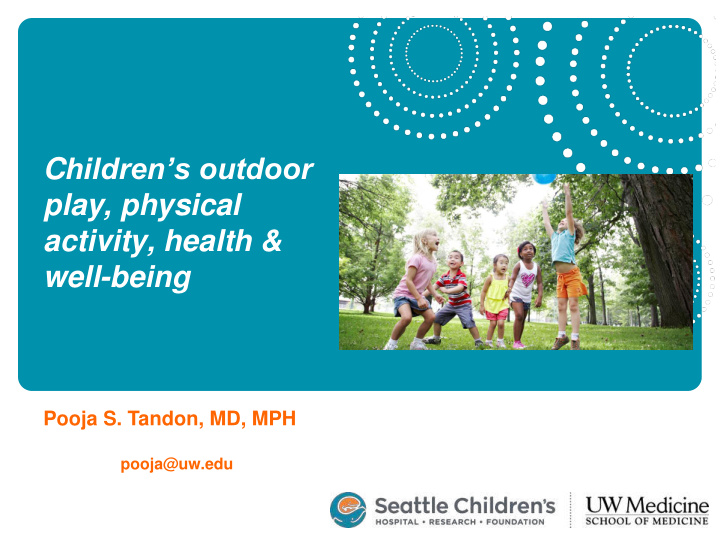



C hildren’s outdoor play, physical activity, health & well-being Pooja S. Tandon, MD, MPH pooja@uw.edu
Over the last several decades, our understanding of the importance of early childhood development has advanced. High-quality early childhood education programs can: • benefit children, parents & society • benefit child development • narrow achievement gaps • boost children’s health and earnings later in life
At the same time, the importance of early childhood as an important period for developing healthy behaviors has become clearer. Childhood obesity prevalence remains elevated among our nation’s youngest: aged 2 to 5 years. (26% are both overweight and obese)
Disparities in obesity in U.S. preschool children Youfa Wang Adv Nutr 2011;2:23-31
Less than 50% of children meet current physical activity recommendations • Only one in three children are physically active every day. 1 • Girls more inactive than boys starting as preschoolers • In 2005, only 35% of HS students met recommended level of physical activity • Less than 5% of adults participate in 30 minutes of physical activity each day 2
Why are children so inactive?
Is there time to play?
But there’s time for this… • 7.5 hours/day with all forms of electronic media • Preschoolers watch ~4 hours of TV/DVDs a day • 32% of 2-7 year olds have TVs in their bedroom
Over 50% of preschoolers don’t play outside daily with parents 100 90 80 70 Percent 60 50 41% 40 28% 30 16% 20 11% 3% 10 1% 0 >once/day about once/day few times/week few times/month rarely not at all Tandon et al JAMA Pediatrics 2012
Why does outdoor time matter? • Being outdoors may be the most consistent correlate of physical activity in young children • US children today spend less time playing outdoors • Active, outdoor play is likely beneficial for motor development, Vitamin D levels, cognition, mental health and other outcomes
How are WA State child care programs doing?
Results: Survey Responses Regarding PA Practices for Preschoolers Centers Homes Category (n=692) (n=1281) 84.7% 82.0% Minimum PA standard met (60 min/day) 12.1% 20.1% Best-practice PA standard met (120 min/day) 85.0% 75.0% Minimum outdoor play standard met (60min/day) 21.8% 21.7% Best-practice outdoor play standard met (90 min/day)
Not much time for physically active play at child care Outdoor Free 2% 2% play 8% 0.1% Naptime 26% Not Active Play 62% Tandon, Saelens, Christakis. Preschoolers' Active Play Opportunities at Child Care . Pediatrics. May 2015. 13
How do these changes impact health & well-being?
How might this relationship work? 3 proposed pathways: (1) the cognitive demands of goal-directed exercise (2) the cognitive engagement required to execute complex motor movements (3) the physiological changes in the brain induced by aerobic exercise (over time) or through cerebral blood flow (acutely)
What is “early learning?”
Isn’t this also “early learning?”
Recommend
More recommend